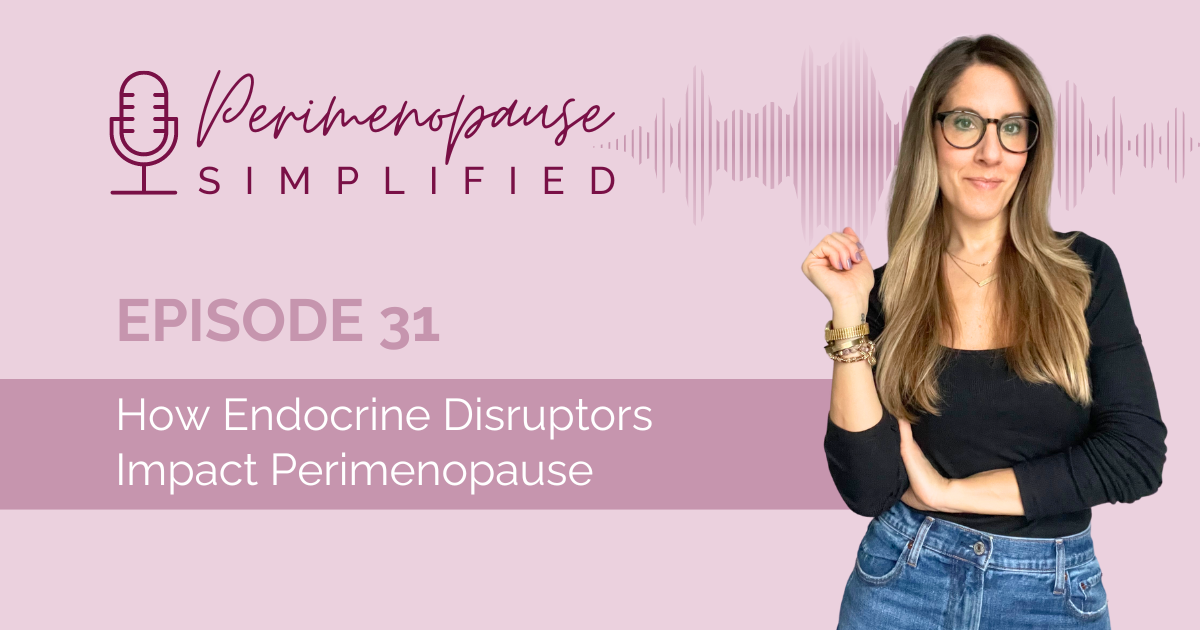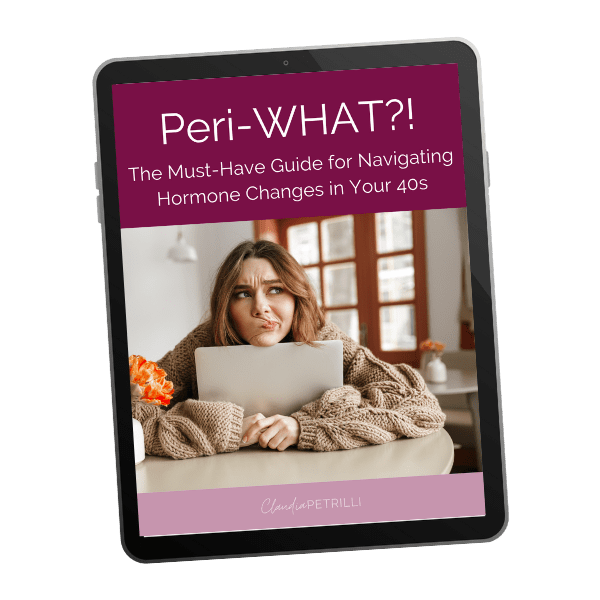
31. How Endocrine Disruptors Impact Perimenopause
Don’t Miss An Episode!
In this episode, we covered:
- What are endocrine disruptors
- How do endocrine disruptors affect hormones
- Why it’s important to minimize them
- Why xenoestrogens are the problem, not estrogen
- Common personal care products to swap
- How to shop safer products
The Overlooked Impact of Everyday Products on Hormones
One thing I never thought about when I first started my health “journey” was how the products I was using on my skin and in my home were potentially affecting my hormones, and in turn, my health.
Before I go any further, please know my intention is never to fearmonger—there’s plenty of that on social media, and I don’t subscribe to it. My goal is to educate, share resources (always check my show notes), and help you make better decisions when it comes to your health. I hope this episode gives you the incentive to start making some swaps and even share this information with people you love.
What Are Endocrine Disruptors?
So, what are endocrine disruptors? They’re natural or man-made chemicals that can mimic or interfere with our hormones, affecting our endocrine system. These chemicals are linked to many health issues.
Hopefully, you’ve been binging my podcast episodes and are learning the importance of hormones for many biological processes. Our hormones need to be at optimal levels—not too high or too low. When they’re suboptimal, this can cause significant effects on the endocrine system and our health.
The Scope and Impact of Endocrine-Disrupting Chemicals (EDCs)
So let’s dig into endocrine-disrupting chemicals. And just for the sake of brevity, I’m going to refer to them as EDCs.
According to the Endocrine Society, there are about 85,000 human-made chemicals in the world, and about 1,000 or so are considered endocrine disruptors. They have been linked to allergies, asthma, hormone imbalance, miscarriages, reduced fertility, neurological damage, and even certain types of cancer.
Recent data suggests exposure to certain EDCs (15 that are being studied more closely) may accelerate reproductive aging and contribute to an earlier onset of menopause.
In 2020, the Midlife Women’s Health Study suggested that exposure to various chemicals, such as phthalates found in hundreds of products used daily, is associated with sleep disruptions in midlife women.
Where Are EDCs Found?
EDCs are found in many products you use every day, such as cleaning supplies, makeup, nail polish, body wash, lotion, deodorant,
food packaging, toys, carpets, pesticides, herbicides, and chemicals in furniture to make it flame or stain resistant.
Many of these EDCs are also known as xenoestrogens because they act similarly to estrogen in the body. While estrogen itself isn’t harmful (we love and need it—you know I’m a fan), exogenous estrogen (not the one we make naturally) can be problematic. And we have hormone receptors all over our body. One of my favorite hormone experts to learn from is Dr. Lindsey Berkson. She refers to these receptors as being “promiscuous.”
How EDCs Affect Your Body
From her book, Hormone Deception, Dr. Berkson says, “Many different estrogenic compounds can unlock the receptor gateways in our bodies just as if they were molecules of our own estrogens—the receptors don’t seem to care. The bigger they are, the more the receptors invite a wide variety of hormone-like chemicals to come in. The only thing that matters to the receptor is the hormone signal, and it’s not concerned about where that signal comes from—whether in the body (endogenous) hormones or environmental (exogenous) sources such as xenoestrogens.”
These can affect your endocrine system by:
- Increasing or decreasing production of certain hormones
- Imitating hormones
- Converting hormones into other hormones
- Interfering with hormone signaling
- Competing with essential nutrients
- Binding to essential hormones
- Accumulating in organs that produce hormones
Research shows that endocrine disruptors can pose the greatest risk during prenatal and early postnatal development when organ and neural systems are forming.
Taking Control: Reducing Your Exposure to EDCs
I know it sounds a bit scary, but I want to reassure you that you have more control than you think. It’s not realistic to completely avoid these chemicals, unfortunately. But when you know better, you do better. It’s important to reduce your exposure when possible.
One thing we tell clients is to start with the products you use all the time—like body lotion, deodorant, makeup, shampoo, or laundry detergent. Start to look at the ingredients in these products. Is it a long list of words you don’t recognize? Most people have never even considered reading labels on the personal care or home products they use. Please start. If you don’t want to google every single ingredient to understand its safety profile, there are apps to help you, which I’ll share in a bit.
Practical Swaps for Everyday Products
Then think about food storage and prep. Are you using plastic and aluminum foil? Consider swapping to glass containers and parchment paper. Are you using non-stick cookware that has PFAS (a class of chemicals that don’t break down easily and can adversely impact human health and the environment)? Consider using stainless steel or cast iron cookware instead. Do you use bleach or other traditional cleaning products? Consider swapping to something like Branch Basics or make your own. You can find plenty of DIY home cleaning solutions on YouTube or Pinterest.
You may also want to consider an air filter, like Air Doctor, which filters many things in the environment like smoke, bacteria, viruses, pollen, mold, but also VOCs, which are volatile organic compounds, such as formaldehyde.
Familiarize Yourself with Common EDCs
Now, I want to go through a list of some of the more studied EDCs so you can familiarize yourself with them and avoid them when possible:
- Parabens: Often found in cosmetics, are listed as a Category 1 priority substance by the European Commission on Endocrine Disruption because of evidence they interfere with hormone function.
- Phthalates: Found in cosmetics and personal care products, may be disruptive to the endocrine system, leading to developmental, reproductive, and neurological damage.
- Formaldehyde: Used as a common preservative, is a carcinogen linked to fetal damage and can cause skin sensitivities or irritation.
- Lead: Can be found in paint, cosmetics, and water; is a proven neurotoxin linked to miscarriage, reduced fertility, and delays in the onset of puberty for females.
- PEGs: Found in cosmetics; carcinogenic and potentially harmful to the nervous system and human development.
- BHT & BHA: Found in cosmetics, food packaging, plastics, and pharmaceuticals; may induce skin allergies, and are linked to organ, developmental, and reproductive toxicity.
- Fragrance: Also labeled as “parfum” or “natural fragrance” in personal care products and home cleaning supplies; has been linked to health effects including cancer, reproductive toxicity, allergies, and sensitivities.
- Coal tar: A known carcinogen, present in the majority of hair dyes and mascaras.
- Atrazine: One of the most commonly applied herbicides in the world.
- BPA: Used to make plastics and resins; can be found in tupperware, water bottles, and in the lining of some canned foods and beverages.
- Oxybenzone: Often found in sunscreens, can cause skin reactions, DNA damage, and is potentially more harmful to children; also toxic to coral reefs and other marine life.
Actionable Steps to Reduce Exposure
Here are some action steps to take:
- Swap personal care products for safer brands; there’s a lot of great brands out there, one that I happen to use and like is Primally Pure—you can use my code: healthcoachclaudia10 to save 10%.
- Consider safer makeup brands: Ilia Beauty, Mineral Fusion, Vapour, RMS, W3ll People, and Juice Beauty.
- Avoid perfume or buy a safer option like Henry Rose.
- Look for an organic hair salon; dye your own hair with Madison Reed or minimize frequency.
- Consider DIY manicures: Zoya, Mineral Fusion, Ella & Mila.
- Swap menstrual products for brands that are free from pesticides, dyes, bleach, or fragrance: Lola, Cora, HoneyPot and/or try a menstrual cup.
- Invest in a water filter because unfortunately, many of these chemicals are in our water supply; I use a Berkey, but another brand is AquaTru.
- Look for Certified B Corporations—they prioritize your health and our planet.
- Check out resources like safecosmetics.org and download apps like Healthy Living or Think Dirty to help you choose safer products when shopping.
Links Mentioned:
Hormone Deception Book by Lindsey Berkson
Cozy Earth (save 40% with code: HEALTHCOACHCLAUDIA)
Sources:
https://www.eurekalert.org/news-releases/876001
https://journals.plos.org/plosone/article?id=10.1371/journal.pone.0116057#pone.0116057.s001
https://www.scientificamerican.com/article/common-chemicals-linked-to-early-menopause/
https://www.ncbi.nlm.nih.gov/pmc/articles/PMC8988816/
https://www.sciencedirect.com/science/article/pii/S0160412024003568
https://www.epa.gov/chemical-research/research-and-polyfluoroalkyl-substances-pfas
https://www.niehs.nih.gov/health/topics/agents/endocrine/index.cfm
https://www.ncbi.nlm.nih.gov/pmc/articles/PMC2858639/
https://www.ncbi.nlm.nih.gov/pmc/articles/PMC4462476/
http://www.safecosmetics.org/get-the-facts/chemicals-of-concern/fragrance
https://ocean.si.edu/ecosystems/coral-reefs/truth-about-corals-and-sunscreen
https://www.ncbi.nlm.nih.gov/pmc/articles/PMC2726844/
https://www.frontiersin.org/journals/endocrinology/articles/10.3389/fendo.2023.1081704/full
Claudia Petrilli is a Functional Health Coach, Integrative Nutrition Coach, Women’s Health Educator, and creator of The Hormone Rescue program. Having experienced debilitating periods, digestive issues, a sluggish thyroid, a pituitary tumor, and perimenopause symptoms in her late 30s, she knows exactly what it’s like to get dismissed by doctors and spend years searching for answers.
To connect with Claudia Petrilli:
FREE GIFT: Peri-What?! The Must-Have Guide for Navigating Hormone Changes in Your 40s
WORK WITH US: The Hormone Rescue Program
QUESTIONS? EMAIL: claudia@claudiapetrilli.com
LOVE THE SHOW?! Please subscribe, leave a 5-star rating, review, and share, so that other women can find this podcast for guidance and support through their perimenopause journey!






